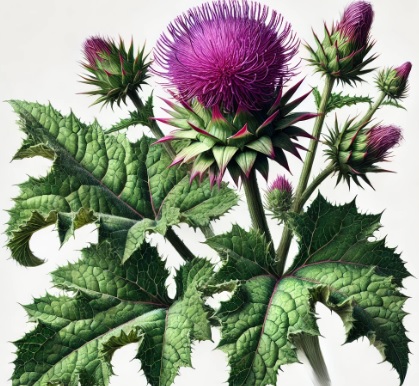Burdock, (Arctium lappa) is a biennial herbaceous plant native to Europe and Asia. It is recognized for its large, broad leaves and distinctive seed heads, which have hooked bracts that cling to clothing and fur. Burdock has been used in traditional medicine for centuries and is valued for its potential health benefits and nutritional properties.
Botanical Classification:
Kingdom: Plantae
Order: Asterales
Family: Asteraceae
Genus: Arctium
Species: Arctium lappa
Plant Characteristics:
Growth Form: Arctium lappa is a robust, biennial plant that can reach heights of 1 to 2 meters (3 to 6.5 feet). It grows in a rosette pattern during the first year and bolts to produce flowering stems in the second year.
Leaves: The leaves are large, broad, and heart-shaped with a rough, hairy texture. They are typically dark green on the upper side and paler with a fuzzy texture on the underside.
Flowers: The plant produces purple or pink thistle-like flower heads in the summer, which are surrounded by hooked bracts. These flowers eventually develop into burs that cling to surfaces.
Roots: The primary edible part of the plant is the root, which is thick, cylindrical, and can grow up to 60 cm (24 inches) long. The root has a brownish, rough exterior and a white, crisp interior.
Chemical Composition and Structure:
Polysaccharides: The root contains polysaccharides such as inulin and mucilage, which are believed to support digestive health and provide prebiotic effects.
Lignans: Arctium lappa is rich in lignans, including arctigenin and arctiin, which are compounds with potential antioxidant and anti-inflammatory properties.
Essential Oils: The plant also contains essential oils that contribute to its medicinal properties. These oils include compounds such as sesquiterpenes and phenolic acids.
Flavonoids: The plant contains flavonoids like quercetin and kaempferol, which are known for their antioxidant effects.
How to Cultivate It:
Soil: Burdock thrives in well-drained, loamy soil with a pH between 6 and 7. It prefers soils that are rich in organic matter.
Climate: The plant grows well in temperate climates and can tolerate a range of temperatures. It prefers full sun to partial shade.
Watering: Regular watering is necessary to keep the soil consistently moist, especially during the growing season. However, avoid waterlogging.
Propagation: Burdock can be propagated from seeds, which should be sown directly into the soil in the spring or started indoors and transplanted once the seedlings are strong enough.
Maintenance: The plant benefits from occasional weeding and thinning to ensure healthy growth. In the second year, it will flower and produce seeds.
Uses and Benefits:
Medicinal Uses: Burdock root is used in traditional medicine for its purported detoxifying and diuretic effects. It is believed to support liver health, improve skin conditions, and enhance digestion. It is often used in teas, tinctures, and capsules.
Culinary Uses: The root is edible and is used in various culinary applications, especially in Asian cuisine. It is often added to soups, stews, and stir-fries. The young leaves can also be used as a leafy green in salads and other dishes.
Health Benefits: Research suggests that burdock may have antioxidant, anti-inflammatory, and antimicrobial properties, contributing to overall health and well-being.
Applications:
Herbal Medicine: Burdock root extract is used in herbal remedies for its potential benefits in supporting liver function, improving digestion, and promoting healthy skin.
Culinary: The root is used as a vegetable in cooking and can be found in various traditional dishes. It is appreciated for its crunchy texture and mild, earthy flavor.
Skincare: Burdock is sometimes included in skincare products for its purported anti-inflammatory and antioxidant properties.
Environmental and Safety Considerations:
Environmental Impact: Burdock is generally considered environmentally friendly. It is a hardy plant that can grow in a variety of soil conditions and does not typically pose a risk to the environment.
Safety: Burdock is generally safe when used appropriately in culinary and medicinal applications. However, it is advisable for individuals with certain health conditions or those who are pregnant to consult a healthcare provider before using it medicinally. The plant is non-toxic and safe for consumption in moderate amounts.
INCI:
Skin conditioning agent. It is the mainstay of topical skin treatment as it has the function of restoring, increasing or improving skin tolerance to external factors, including melanocyte tolerance. The most important function of the conditioning agent is to prevent skin dehydration, but the subject is rather complex and involves emollients and humectants that can be added in the formulation.
Synonyms:
CAS:
![]() Burdock
Burdock 

